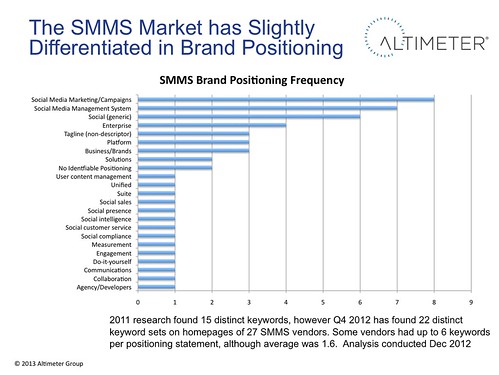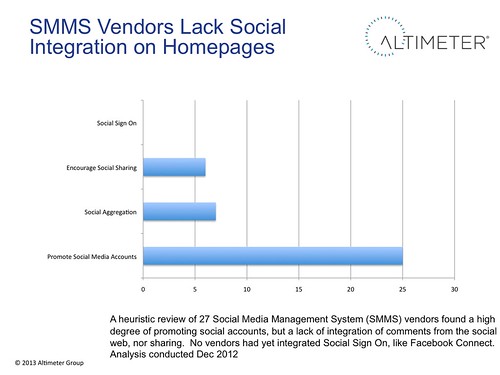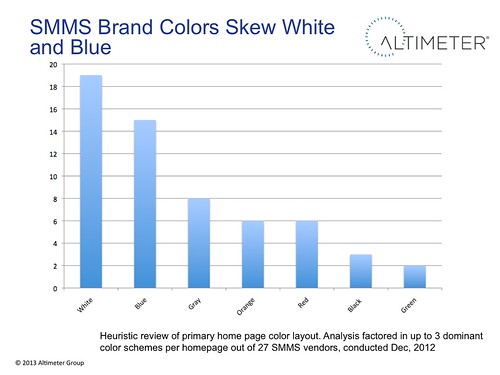Market Positioning Signals Company Capability and Market Maturity
Messaging is often the first thing prospects, investors and analysts see, so it’s important to focus on it as much as core capabilities as we’ve done in our research report which has been viewed 164k times on the vendor landscape. Over a year ago, I conducted the same exercise to compare the positioning of this same space, and wanted to compare the changes in the space based on data and then draw insights.
Method: Visiting Each Vendor’s Website, Like a Buyer
This exercise was conducted in the mindset of the buyer (heuristic review as a social marketer and executive) using the following method: First, I built a list of vendor names, working with Altimeter’s Andrew Jones, then, I put myself in the place of the buyer and imagined their task of sorting through this new space and short listing it. Then, a researcher and I went to each website homepage to glean the keyword set, graph on worksheets and conduct data analysis. We looked at tag lines, slogans, keywords, browser title tags.
After some data modeling, here’s the positioning each of the 27 vendors, including: Actiance, Argyle, Awareness Networks, Buddy Media (Salesforce), Context Optional (Adobe Social), ConverSocial, CoTweet (Exact Target), Engage Sciences, Expion, FALCON Social, Friend2Friend, HearSay Social, Hootsuite, HYFN8, Liveworld, Shoutlet, SocialVolt, Spredfast, Sprinklr, SproutSocial, Syncapse, Targeted Group, TigerLily, Tracx, UberVU, Vitrue (Oracle) and WildFire (Google).
Here’s a list of all the positioning statements. Two of the positioning statements had vendor names included in them, which I changed below to “vendor”.
- One Platform to Manage All Your Communications & Collaboration
- Professional Social Media Management
- Acquire customers, socially
- The world’s only unified social marketing suite
- It’s time to take the guesswork out of social media.
- Powering Social Customer Service
- Create Exceptional Social Media Marketing Programs
- Empower, Centralize, and Localize Your Social Presence
- Complete Social Media Management for Teams and Enterprises
- Vendor Powers Social Engagement
- Succeed with the leading enterprise social sales, marketing, and compliance software
- Social Media Management
- Do Social. Better.
- Vendor is a user content management company providing technology and services to help brands scale social media.
- The only do-it-yourself, all-in-one social marketing platform
- Manage Social Media Across Networks, Accounts, Staff and Brands
- Social Media Management
- Social@Scale
- Social media management for exceptional companies.
- Enterprise social media marketing, management, measurement and platform solutions
- Social Media Marketing Agency
- Stand out on the social web
- Social intelligence
- Solutions for social media marketing
- Build brands on social with Vendor
- Complete enterprise social media marketing software
- NA: There was one vendor where the market positioning was not clear
Findings

Above: Even after over a year, the market still focuses on keyword terms like Social Marketing, SMMS there was increased deviation in market. Last time 40% used SMMS (10/25) or Social Marketing (10/25 or 40%) as the highest frequency. This year, 8/27 used Social Marketing in taglines, which is just about 30%. What was interesting is that we’re seeing some unique identifiers used by just a few vendors, showing that they’re slight differentiation from player to player.

Above: Ironically, most of these SMMS vendors were not integrating social onto their own corporate websites. While 25 of the 27 would link away and promote their social media accounts, only 7 were aggregating discussions from their own market place and a few were explicitly encouraging sharing of content. None had Social Sign On (SSO) which I consider is a sign of social maturity.

Above While not an indicator of much, there was a strong preference for white and blue brand colors. Those that didn’t take to this could potentially stand out if all logos were listed on one page. In my experience, blue tends to be a dominant color in tech field, so there isn’t that much of a surprise.
Market Findings
There’s a number of smaller, interesting findings that I wanted to include from the study.
- There were multiple acquisitions resulting in the influx of the parent brand (Oracle, Adobe, Salesforce, ExactTarget)
- We found that 21 of the 27 vendors had business value messaging (offers to improve customer value, business value) and 8 of the 27 had feature and function capability offerings. Tracx and Falcon were able to pull off both at same time.
- In the last study, SMB was marketed as a keyword set, but was not in this current finding set.
- Since being acquired by Salesforce, Buddy didn’t use campy tagline “everyone needs a buddy”
- We found that Syncapse and Hearsay had a much larger keyword set indicating that they have wider capabilities. Our research in previous reports correlated with this as Syncapse scored strong in multiple categories and Hearsay has a strong foothold in Legal, Risk, Compliance, and Financial Services, a unique market to manage.
- The research team was confused by CoTweet’s lack of positioning on the page, and would expect that prospects would be left scratching their head and either look for additional information, or leave.
- Sprinklr had a unique message “Social@Scale” which is both plays to their identifiable capabilities, unique, and marketable beyond a campy slogan.
- Awareness provided a verb based tag, “Acquire customers, socially”, but didn’t say what would happen afterwards (management, growth, support, etc)
- For kicks, there are fewer than expected animal logos, with Hootsuite owl, Tracx primate, Tigerlily grinning feline, and a wing from Falcon. Had Seesmic been around, we would have added a crook eyed Raccoon.
- Spelling-wise, this market is still plagued with oddly spelled vendors names. I find myself frequently have to tell clients how to correctly spell it out, slowing down inquiry calls. This includes vendors like HYFN8, Sprinklr, Spredfast, Tracx, UberVU and Vitrue (Oracle).
Research Summary
Overall the market is still pinning on social marketing and SMMS as a category. There was slight market differentiation matching the deviation as the market continues to mature. Some vendors are finding some unique categories to market their offerings, while some are still going broad to appeal to a larger set. Expect to see more M&A this coming spring as incumbent software vendors need to quickly get in the game, I’ll post more on this in future.
Credits to third party researcher Julie George for the data collection via TaskRabbit.
(Disclosure: I’m VP/Mktg @Sprinklr)
Jeremiah–You continue to help all the buyers in the market achieve the clarity they need. Thank you for that.
Obviously, we appreciate the call-out re: Social@Scale because we firmly believe that
1. social is bigger than just marketing
2. “being” social is different than doing/managing social
3. when a large enterprises seeks to “be” social at scale, it necessitates a different set of priorities and features than what worked previously.
That being said, in the spirit of authenticity, we are guilty of not having SSO yet (in the pipeline) and not being as social as we could/should be on our homepage/website. You are right to expect that of a company such as ours.
Keep up the great work and glad to see you starting 2013 off with a bang.
Great research! At this time last year, my team at Friend2Friend played “guess the vendor” with the rundown of taglines you listed; back then it was somewhat easier. Looking at the list from a buyers perspective now makes it clear just how challenging it is for brand marketers to make a choice. While maturation is occurring, there is still substantial market fragmentation.
We see this continuing for a while yet. The social media market is still fast forming and creating a broad array of new challenges: dealing with the fusion of social/mobile; handling the daunting task of cultivating fans across social platforms; successfully incorporating commerce; integrating channels outside Facebook like Pinterest, Tumblr, Twitter, Instagram into a cohesive social marketing effort; and holistically managing a paid/earned/owned media mix to deliver a compelling ROI. Today, no one vendor’s solution “does it all,” and brands are still relying on smaller, nimble vendors to offer innovative solutions. The major brands we work with are forced to work multiple vendors for their social solutions. They are constantly challenged to come up with creative and unique social brand solutions, all the while dealing with technical challenges, and managing a budget that is split between web, mobile, social and print. In summary, these are still early days in the SMMS/social media marketing space — for marketers the journey promises to be full of opportunity and challenges.